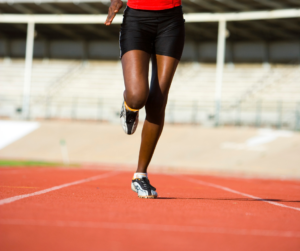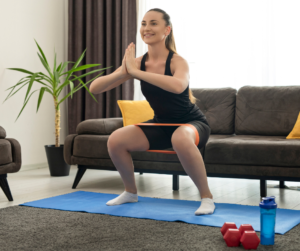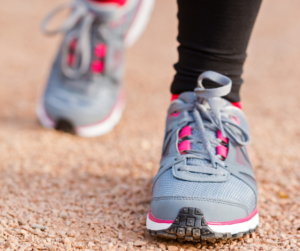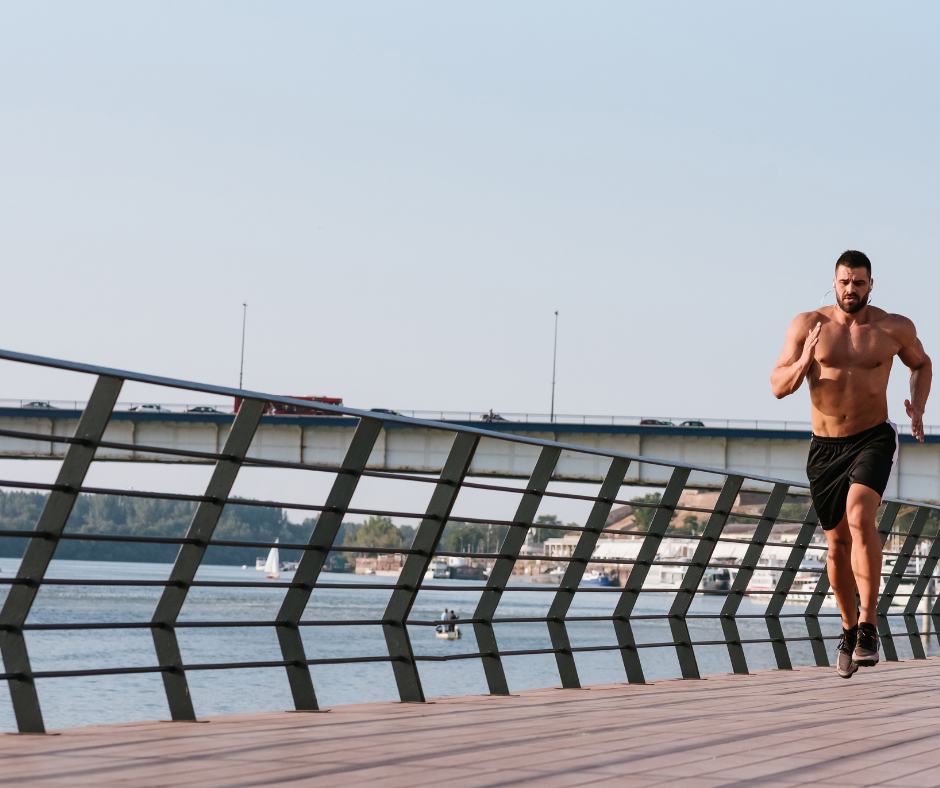During that crazy time in all of our lives, where we were working from home, gyms were closed and we were not allowed to see family members. Health experts encouraged solo outside exercise for physical and psychological well-being and a lot of people found their escape by running.
Whatever your reason for hitting the trails, pavement, or track is, by following a few simple tips and guidelines, you’ll be able to stay motivated, injury-free, and safe while becoming a faster, fitter, and stronger runner.

Firstly, let’s cover the basics…
Types Of Running
There are 7 main types of running, they all help to achieve different objectives.
7 Different Types Of Running:
- Base Runs
When you run a base run, you run at your natural pace for a length of time that doesn’t push or challenge you, this type of run is great for building endurance.
- Fartlek Runs
Fartlek (Swedish for “speed play”) runs, this type of run includes interval training with a long-distance goal.
You would run at a fast pace for part of the run but intersperse slower speeds for short amounts of time.
- Interval Runs
Intervals or speed workouts are done to increase aerobic capacity.
While doing interval training you would alter between running at a fast pace and then at a slower pace.
- Long Runs
By doing long runs you will be able to acclimate your body to exertion over increasingly longer periods.
This Is Why You Need To Include Long Runs In Your Training: Click Here
- Recovery Runs
These are easy runs at a shorter distance or slower pace than usual. These are run to help your body be capable of peak performance on race day.
Recovery runs are very important for several reasons.
Longer than interval distances but shorter than long runs. Tempo runs are generally up to 10 miles long and executed at a challenging but sustainable running pace that will closely align with your projected race pace.

- Track Runs
It’s normally elite runners that like to perform speed intervals on track surfaces, finding that the springier surface works well for repetitive speed drills.
It doesn’t matter if you’re brand new to running or jumping back into it after a long break.
The most important thing to remember is to take it slow and start EASY.
Here are some tips to take into consideration that will make a HUGE difference to your running.
Expert Tips For Beginner Runners
- Begin slowly.
- Nutrition is key.
- Follow a walk/run method.
- Stick to your strategy.
- Recovery is also key.
- Strength training.
Begin Slowly
Now that you’re starting to run, your body will need to get comfortable with the new load that comes with running on your joints.
The slower you start the higher your chances are of avoiding overexertion, pain, and injuries. The easier you run, where you can easily hold a conversation, the faster you will build up endurance and start to see improvements.
It sounds counterintuitive but Coach Lindsey Parry reveals in this video why you should slow down if you want to speed up and run faster.
Nutrition is key
Immediately after a run, it’s important to refuel your body with protein and carbohydrates to restore your glycogen and repair the muscles.
The first four hours after exercise is a crucial time for taking on new glycogen to replace what you’ve lost while working hard.

Within 30 minutes after your training, you should consume the correct sugars and protein. As we get older this becomes even more important. You should also drink enough as keeping hydrated will also contribute to speeding up your recovery time.
In a nutshell, during exercise, we have what are called gated channels. These are channels through which the body takes sugar out of the blood, through the membranes, and then pushes them into the muscles where they are needed most.
The gated channels are very sensitive during exercise, but they close down and draw that sugar into the muscles much slower once you get out of the 30-minute window.
So, essentially, every 15 minutes, our body’s ability to replace the muscle glycogen, in particular, decreases by roughly a multiplier of 50. (50% less efficient as we go). Therefore 45 to 60 minutes after our exercise it becomes difficult for our bodies to reload that muscle glycogen.
Follow a Walk/Run Method
At Coach Parry, we are huge fans of the run/walk strategy.
The run/walk strategy should be done often enough until you are comfortable enough in what you are doing.
It’s not something that you need to do in every single session, a good time to implement this strategy would be on one of your long runs.
The important thing about the run/walk strategy is not how much running you do vs how much walking but more about settling on a routine that you are comfortable with and that you can implement from the get-go.
We recommend 1 to 2 minutes of brisk walking every 3 to 6 kilometers, and then of course you need to factor in a bit of extra walking on the hills.
It’s SUPER good to implement the run/walk strategy on long or very steep hills. (e.g Run 1 min, walk 1 min)
The point of the walks is to keep you feeling fresh and your legs feeling strong for as long as possible so that your average speed improves over the long term.
Find out how to implement the run/walk strategy here.
Stick To Your Program

Yes, we understand life is busy and days tend to get away from you…
Lack of consistency impacts improvements over time.
A great way to think of consistency is as if it were a financial investment.
The small little bits over time lead to big amounts and that’s the same thing as fitness.
You should aim to stick to your training plan as well as possible.
Do this by following a customizable training plan like the ones we have at Coach Parry.
Recovery Is Also Key
When you run, you aren’t just building your stamina and strength; you’re also breaking your body down, causing a tiny amount of tissue damage with every step.
Allowing yourself time to recover after your runs is what makes it possible for you to come back better adapted for your next run.
We can’t stress the importance of recovery enough. It is as important as your training.
Without recovery, you won’t reach your full running potential. On top of that, by not recovering you increase your chances of getting sick and injured.
If you would like to learn more about the role of recovery then be sure to have a look at our extensive practical guide to running recovery.
Strength Training
Strength training helps keep you injury-free.

Running is a compounding sport, it places eccentric strain on your muscles.
Strength training helps build the structures around the joints and helps make the joints stronger, allowing your body to sustain the load from running so much better.
Strength training has massive effects on your running performance.
You will improve your running performance by not even running at all. Ideally, you should be doing resistance training once or twice a week, as this is when you will reap the most benefits in your running.
Making sure you do the correct strength training is important. The good news is we’ve created a free strength training plan for runners that you can download by clicking here.
The team at Coach Parry has a lot of experience behind them…better than that, put together the Coach Parry community has even more experience, that’s why we asked them what they wished they had known when they started running…
What We Wish We Knew When We Started Running
The magic happens when you sleep.
The reason why the magic happens in your sleep is that it is the time when your body is working the hardest at regenerating.
This happens because humans were designed to be diurnal, which means that we sleep when it’s dark and be awake when it’s daylight.
Our hormonal responses are triggered by the changing of the light. Certain processes need to take place at certain times for us to get the best adaptation (recovery) while we are sleeping.
When you get into bed is the most important. If you get into bed after 10 pm then there will be a reduction in the peak release of hormones(Human Growth Hormone & Testosterone) while we are sleeping.
The importance of getting the right running shoes.
This is an important factor considering that you are running in them for hours.

When buying running shoes, a key thing to look out for is that the shoes fit you correctly, it is going to be a personal preference, no brand is better than another… it comes down to what works best for you.
You should try to test different models of shoes to see what fits right and to see what’s recommended.
We strongly advise going to a specialist retail store, where they can talk you through different shoes.
Something to look out for when purchasing your running shoes is the actual fit. There needs to be a little bit of space in front of the big toe, the shoe must not be too constricting around the bridge or top of your shoe.
Something else to look out for is the right kind of shoe in terms of pronation and anti pronation shoes.
A lot of running stores might get you to walk up and down and have a look at your feet and give you a pair of anti pronation shoes.
Pro Tip: For about 90% of people, maybe even more, you can get away with a neutral shoe. It is only in extreme cases that we would recommend you get anti pronation shoes.
Following a structured training plan would give me the results I wanted, rather than what I thought I knew.
Following a structured training program is the KEY to doing things the correct way.
The reason for this is that when you have a structured training plan, it has been scientifically thought out and built up progressively, it takes into account the right amount of rest & intensities that you need.
If you don’t follow a structured plan then you land up doing the things that you like to do and not the things that you don’t like to do and you probably won’t get enough rest.
Following a training plan takes the guesswork out of it for you as the runner.

The older you get, the more important recovery becomes.
This wish applies to everybody.
The MAGIC happens while we recover, not while we exercise.
As you get older you consistently lose strength, that’s why recovery becomes even more important. So as a result you end up working harder, which means that you will require a longer recovery time.
You don’t have to race every time you run.
A lot of runners believe that you need to be half-dead after every session for that session to be worth it. This is NOT the case.
Only 20% of your overall volume of training needs to be done ‘hard’.
When you constantly run hard you increase your chances of overtraining and causing injury.
Vaseline is not optional.
This one is so true… although funny, Vaseline is necessary!
Experiencing chafing during a run can be extremely uncomfortable.
There are tons of products out there, Vaseline being one, that can be applied to areas where chafe is common like between your thighs, under your armpits, and where your heart rate monitor goes.
We touched a bit on why following a training program is necessary to remain consistent and to improve your running performance safely without injury.
Let’s have a look at what and what shouldn’t be included in your training plan…
Check it out in the video here!




Comments are closed.